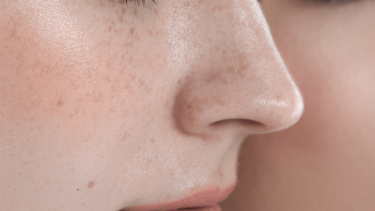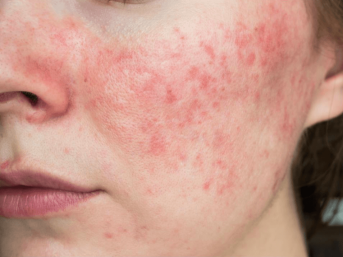Rosacea
Rosacea is a chronic inflammatory skin condition. It is localized in the centrofacial region, with clinical signs that include erythematous plaques, telangiectasia, papules, pustules and edema.
There are several subtypes of rosacea, including erythematotelangiectatic, papulopustular and hypertrophic rosacea.
- Read more
-
It develops chronically and can be complicated by sometimes severe ocular damage, pyoderma faciale (rosacea fulminans) and rhinophyma (severe hypertrophic form).
It is characterized by alternating periods of exacerbation and remission.
It occurs predominantly in women with light phototypes after the age of 30. It is sometimes mistaken for acne, which can cause problems as acne products may further irritate the fragile skin of someone with rosacea.
It can be linked to genetic factors (family history, etc.) and there are triggering factors (invasion by microbial agents such as Demodex, stress, sunlight, extreme temperatures, spicy foods, hot drinks, alcohol and tobacco).

The erythematotelangiectatic form
This is characterized by transient erythema called flushes and/or permanent erythema in the centrofacial area (erythrosis), affecting the nose, cheeks, middle of the forehead and chin, which is the most characteristic sign of rosacea. It occurs together with facial telangiectasia (couperose).
Flushes are sudden sensations of warmth that cause redness without any other systemic signs. This lasts for a few minutes or hours, then spontaneously disappears.
Several factors can contribute to their development:
- Genetic predisposition: some people are more predisposed to developing telangiectasia because of their genetic make-up.
- Prolonged exposure to the sun: the sun’s UV rays can damage blood vessels, causing them to dilate.
- Hormones: hormonal fluctuations, for example during pregnancy, can trigger onset of telangiectasias.
- Skin lesions: injuries, inflammation or a previous medical procedure can damage blood vessels and cause the formation of telangiectasias.

The papulopustular form
In someone with erythro-couperose, inflammatory papules and/or pustules will appear, often resembling acne lesions. They can be painful and generally evolve in flare-ups.
They usually appear on the cheeks, nose, forehead and/or chin, and may be combined with persistent redness, dilated blood vessels (telangiectasia) and skin sensitivity.

Summaries of publications and clinical results
Find all our summaries by expertise.
View all summariesWant to read on?
This access is reserved for professionals, registered on Pierre Fabre For Med.
To access the full content, please register or log in if you already have an account.